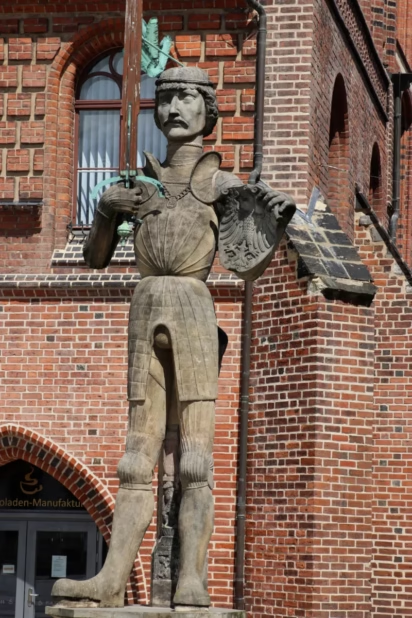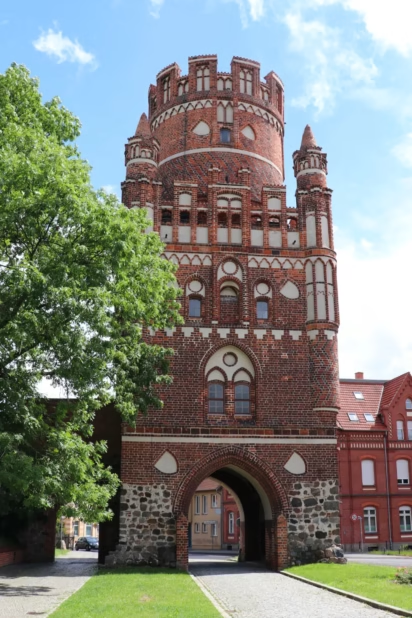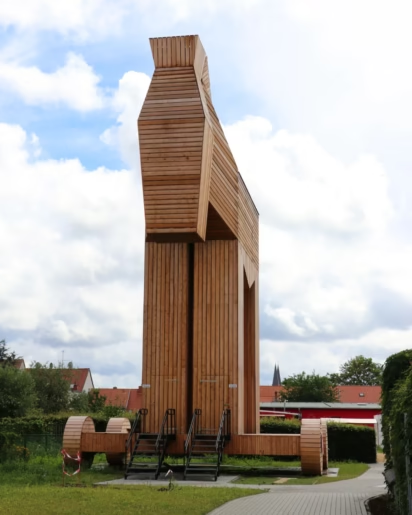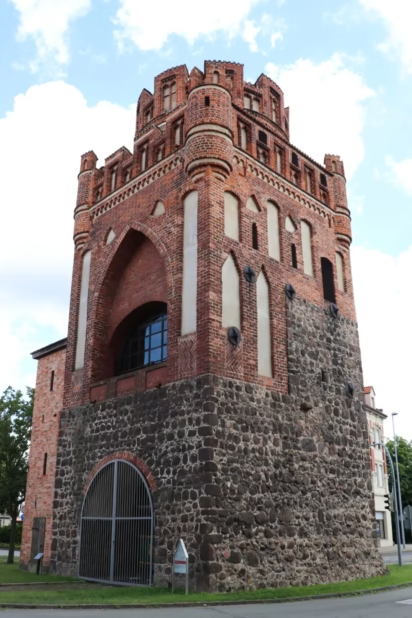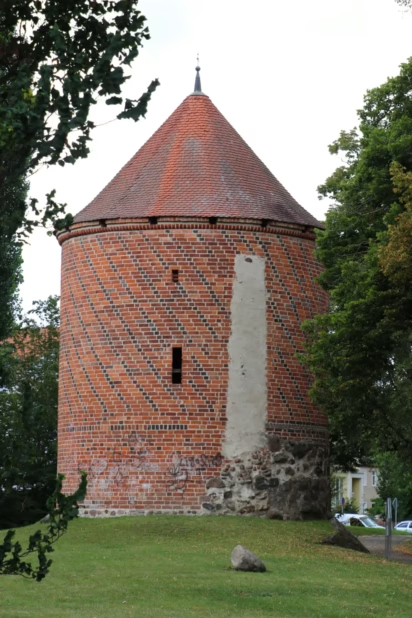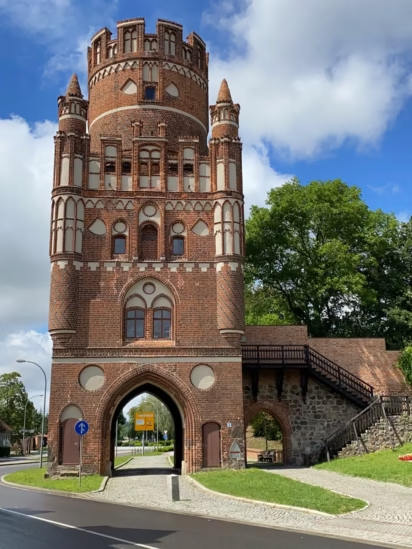The brick Gothic Uenglinger Tor and Romanesque Tangermünder Tor are two beautiful medieval town gate towers in Stendal in Saxony-Anhalt, Germany.

Only two of Hansestadt Stendal’s medieval town gate towers survived but both are exceptionally beautiful: the brick Gothic Uenglinger Tor is the better looking but the Tangermünder Tor with early 13th-century Romanesque base is the older. Both are worth seeing and may be scaled for fine views of the historic old town with numerous Gothic churches. Stendal, a town of nearly 40,000, is in the Altmark region of northern Saxony-Anhalt and easily reached by car or train from Magdeburg, Wolfsburg, and Berlin.
Brief History of Stendal
Stendal was officially founded in 1160 when the Brandenburger Margrave Albrecht the Bear gave Stendale market rights. However, archaeological finds indicated permanent settlements in the area already in the 9th century.
Medieval Stendal was a relatively rich city and an active member of the Hanseatic League (from 1358 until 1518). Hansestadt (Hanseatic City) was officially added to the town name again from 2009.
Wealth not only gave Stendal many Gothic churches but also necessitated from around 1300 town walls. Stendal’s complex medieval defense system included two moats (Gräben) and two earth ramparts (Wällen) with a wall on the inner embankment, and four town gates. Water from the Uchte fed the moats — it still flows through the moat to the south of the old town.
Much of the defenses were torn down in the 18th and 19th centuries but the inner embankment is still a green area with an elevated promenade leading around the old town area. “Wall” in the modern street names largely indicate where the original outer defenses were.

Stendal was a Prussian garrison town from 1640 and the last Red Army troops only left in 1994. It thus has many war memorials, that were often altered with regime changes.
Due to its military installations — the boxer Max Schmeling was the most famous recruit — Stendal was a target for air raids in the Second World War. The town mayor, Karl Wernecke, hoisted the white flag and prevented the town’s destruction by surrendering without a fight to the US Army on 13 April 1945. Goebbels thus described Stendal as “ehrlos” (without honor). Wernecke escaped the Nazi death sentence but after the Soviets took over in July, Wernecke was sent to Sachsenhausen where he died in December 1945.
Brick Gothic Uenglinger Tor in Hansestadt Stendal

The brick Gothic Uenglinger Tor is the medieval tower gate tower in the northwestern corner of the medieval Stendal.
The Uenglinger Tor dates from 1450/60 and is often attributed to Steffen Boxthude, a major fifteenth-century builder master in North Germany. The beautiful brick stepped gable over the northern entrance of the Dom St. Nikolaus is also attributed to him.
The Gothic arch gate in the tower, as well as a smaller one directly next to the tower, is now always freely open to pedestrians.
The square brick tower above the gate is topped by a fortified defensive platform with turrets in each corner. A further round tower adds a higher viewing platform, which is only open during busy holiday periods. In total the tower is 27.5 m high — almost double Stendal’s average 32 m above sea level.
Like the massive Holstentor in Lübeck, Uenglinger Tor was as much built to impress as to defend against attacks. The tower is richly decorated with friezes, blind arcades, and contrasting details.
During the middle ages, a smaller forward tower and further bastions would have been the first defense against an attack from the countryside with the main tower only coming into play if the first defenses faltered. (Such a set up may still be seen in more complete form at the Neustädter Tor in nearby Tangermünde.)
Near the Uenglinger Tor small sections of the town wall and a Wiekhaus — a house built into the town wall — may still be seen in Wendestraße.
Nearby is also the Winckelmann-Museum dedicated to the local-born Johann Joachim Winckelmann (1717-1768) a very important pioneer in archaeology and art history. His work inspired the French writer Marie-Henri Beyle (1783–1842) to use the pseudonym, Stendahl. If not visiting the museum, at least peek through the fence to see the largest wooden Trojan horse in the world. It is used as a viewing platform — at 15.5 m not quite as high as the gate tower but the museum maintains longer opening hours.
Romanesque Brick-Gothic Tangermünder Tor in Stendal
Stendal’s southern town gate tower, the Tangermünder Tor, is the older of the two surviving gate towers. Its stone base with a typical Romanesque half-round gate dates from the first decades of the 13th century. It claims to be the oldest surviving town gate in northern Germany.
The brick Gothic upper levels were added around 1440 and are thus also slightly older than the Uenglinger Tor in the north. It also has a square base with corner turrets at the bastions with a further smaller round tower on top. In contrast to the Uenglinger Tor, the gate of the Tangermünder Tor is closed off with the space used by the nearby Altmärkisches Museum (local history) as exhibition space.
The nearby round Pulvertor (1450) is the only medieval defense tower that survived in Stendal. It now stands on its own in the green promenade area but it is easy to see how the town wall was originally connected to this tower.
Transportation to Stendal
Getting to Stendal is easy by car or public transportation (train) from most parts of Germany. Although the Autobahn A14 will only reach Stendal from Magdeburg around 2025 (and around 2030 from Schwerin), the road network is well developed and the quiet countryside a joy to drive in. Many other smaller sights in the region such as beautiful Tangermünde, Kloster Jerichow, and Havelberg are easily seen en route if traveling by car. Driving times (and distances) to Stendal are around an hour (60 km) from Magdeburg, 1h20 (90 km) from Wolfsburg, and two hours (120 km) from Berlin.
Stendal has very good long-distance and local railway connections. Traveling times to Stendal by frequent train are around 40 to 45 minutes from Magdeburg, 30 to 60 minutes from Wolfsburg, 60 to 90 minutes from Berlin (direct or one transfer), and just over 5 hours from Amsterdam. See Deutsche Bahn timetables.
A useful local bus is line 900 with connections to Tangermünde on the Elbe and Havelberg.
More on Hansestadt Stendal
- Brick Gothic Town Gate Towers with a brief history of Hansestadt Stendal and transportation information
- See Medieval Stained-Glass Windows and Art in the St. Jacobikirche
- Fantastic Stained-Glass Windows in the Dom St Nikolaus
- Hansestadt Stendal Tourist Information
- Deutsche Bahn Timetables to Stendal
- Tripadvisor Recommendations for Hotels and Restaurants —nearby Tangermünde is hugely popular with weekend guests from larger cities and thus has a bigger choice and variety. Book in advance on summer weekends, especially for better restaurants.
- Kloster Jerichow — the oldest brick building in Northern Germany / East of the Elbe River
- Havelberg — a lovely small town with an interesting Romanesque-Gothic collegiate church.
- More photos on Flickr of Hansestadt Stendal
